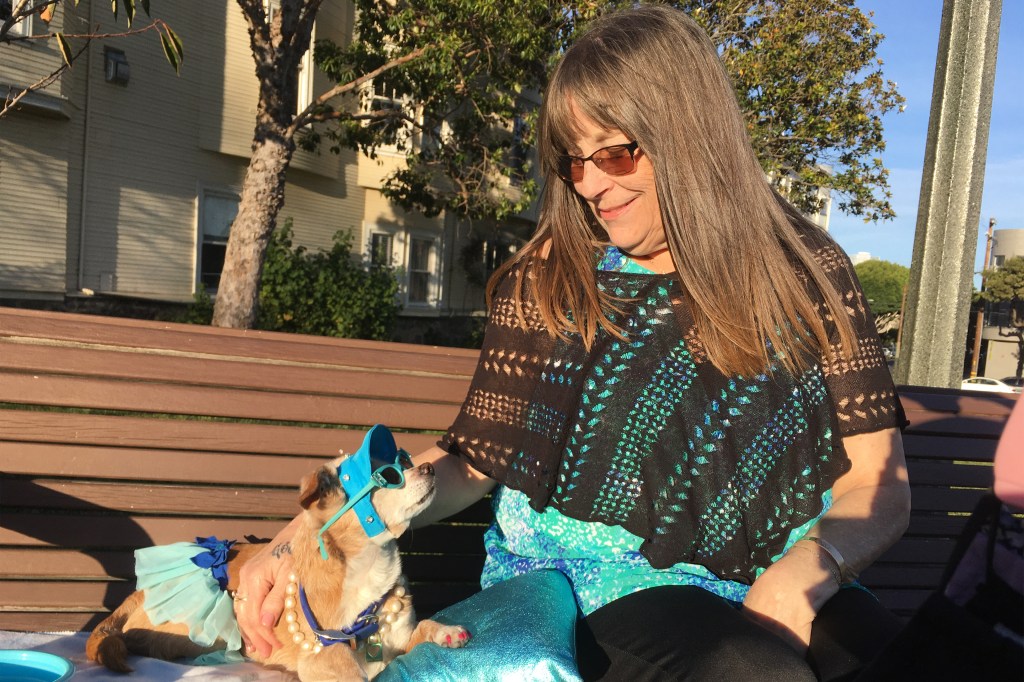If you or someone you know is considering suicide, please call the National Suicide Prevention Lifeline: 1-800-273-TALK (8255).
At the park near Duboce Triangle in San Francisco, 5 p.m. is canine happy hour. About 40 dogs run around, chasing balls and wrestling, as their owners coo and ’90s hip-hop bumps out of a portable speaker.
One recent afternoon, a Chihuahua mix named Honey lounged on a bench wearing a blue tutu and a string of pearls. Her owner, Diana McAllister, fed her homemade treats from a zip-close bag, then popped one into her own mouth.
After spending two years at home through the pandemic, it’s clear that for a lot of these owners, their dogs are their children.
“I always say, dogs are people, so I love him,” said Yves Dudley, looking on as her 9-month-old collie-schnauzer mix played in the grass.
Across the country, about 23 million families adopted a pet in the first year of the pandemic. Other pet owners, working from home, started paying more attention to their animals’ daily routines, noticing symptoms like vomiting or coughing. The resulting spike in pet health concerns has been straining a corner of the medical world that doesn’t get as much attention as doctors and nurses: veterinarians.
The overwork and staffing shortages of the pandemic have affected veterinarians as much as other doctors and nurses, and dealing with the constant moral dilemmas and emotional output was driving many to burn out even before 2020. The mean salary for vets is about $110,000 per year, according to the Bureau of Labor Statistics, about half that of physicians catering to people.
At the Society for the Prevention of Cruelty to Animals’ veterinary hospital in San Francisco, so many vets and technicians have left that the clinic has had to cut back its hours, said veterinarian Kathy Gervais.
Dog owners say they’ve had to wait months for vet appointments or drive to vets far from home to get care.
“Getting your dog in to see the vet is as competitive as trying to buy Coachella tickets online,” said Laura Vittet, whose golden retriever, Gertrude, is 1½ years old. “You have to wait by the phone, you have to be ready to refresh your browser. It’s a very intense experience.”
Gervais said she works 12-hour days, constantly zigzagging from new puppies to dying cats. And the whole time, she takes care of their humans, too.
“To these people, and especially in these times, this is their love,” she said, thinking especially of the owners who dress and coif and cook for their dogs. “This is their being, this is what they live for. And for vets, it’s very hard for us to draw the line.”
Empathy overload and compassion fatigue affect veterinarians’ mental health. They carry the weight of having to euthanize animals that could be saved but whose owners can’t afford the care. Gervais said her practice euthanizes about five animals every day. Some upset owners become downright abusive when a pet is in distress, berating vets or later bullying them online.
“I dare you to try to talk to a veterinarian who’s been in practice more than five years who doesn’t know somebody who has committed suicide,” said Gervais. “I, unfortunately, can count on more than 10 fingers: classmates, colleagues, people I’ve dated.”
One in 6 veterinarians have considered suicide, according to studies from the Centers for Disease Control and Prevention. While male vets are 1.6 times as likely to die by suicide as the general population, female vets are 2.4 times as likely, and 80% of vets are women.
In the early months of the pandemic, Gervais could see things getting worse. She helped organize the Veterinary Mental Health Initiative, which offers free support groups and one-on-one help to vets across the country.
All the facilitators have doctorate-level training, said founder and director Katie Lawlor, also a psychologist, and they’re all familiar with the issues troubling vets.
“Burnout, compassion fatigue, managing panic attacks, how to communicate with both supervisors, colleagues, and clients when you’re under extreme deadlines or very intense stress,” she said. “And the loss of their own companion animals.”
The initiative helped Dr. Razyeeh Mazaheri work through the anxiety she was feeling every day caring for animals at a clinic outside Chicago last year. The clinic was regularly double- or triple-booked. As a new vet — Mazaheri graduated from veterinary school last spring — juggling so many cases was terrifying.
“I just feel like if I make a mistake, that is a problem. And if I make a mistake and kill something, that is my fault,” she said, tearing up. “I just knew that I was burned out.”
Through the support groups, Mazaheri was able to see that others shared her concerns and she learned coping tools. The initiative, housed under the nonprofit Shanti Project, has groups specifically for emergency vets, vet technicians, recent grads like Mazaheri, and longtime vets like Kathy Gervais who have more than 20 or 30 years of experience.
“I’ve had people look at me sometimes when they’ve seen me really tired, going, ‘Kathy, walk away,’” she said.
“I’m not ready to do it because, bottom line, I love my job. It is a vocation. It is a passion. And it’s hard to walk away from that,” she said. “But if it’s going to kill me on the flip side, I would hope I could just say, ‘OK, that’s it. I’m done.’”
This story is part of a partnership that includes KQED, NPR and KHN.
